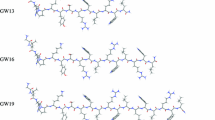Abstract
Nowadays, targeted therapy of cancer is under intensive focus of many investigations due to severe side effects imposed by various cancer chemotherapeutics. BR2 is a modified antimicrobial cell penetrating peptide with confirmed capability of delivering various cargos specifically to cancerous cells. However, because of its small size, its recombinant production by conventional methods is difficult, and its chemical synthesis imposes high cost. Hence, the aim of the present study was to evaluate if recombinant production and intein-mediated purification of this peptide is possible and finally evaluate its safety as a suitable targeted drug delivery vector on cancer and normal cell lines. In this regard, the coding sequence of BR2 was cloned in pTBX1 to be expressed in-frame with GyrA intein and then subjected to inducible protein expression using IPTG. Afterwards, the expressed protein was transferred to chitin-loaded columns and the peptide was purified according to manufacrure’s instruction. SDS–PAGE and Western blot analysis confirmed the expression of BR2-GyrA fusion protein by showing a band of approximately 31 kDa. Moreover, SDS–PAGE of the purified peptide showed a band of approximately 3 kDa, confirming the successful purification of BR2. Finally, in order to evaluate the safety of the produced peptide, its effects was evaluated on MCF-7 and HEK-293 cell lines by MTT assay, and compared to the effects of chemically synthesized BR2. Statistical analysis of the MTT assay results showed that the recombinantly produced peptide had no significant toxic effects on MCF-7 and HEK 293 cells, comparing to negative control, and this was similar to the effects of the synthetic BR2. Hence, the recombinant BR2 can be used for production of novel vehicles for targeted delivery of cytotoxic cargos in the future.






Similar content being viewed by others
References
Ansari C, Tikhomirov GA, Hong SH, Falconer RA, Loadman PM, Gill JH et al (2014) Development of novel tumor-targeted theranostic nanoparticles activated by membrane-type matrix metalloproteinases for combined cancer magnetic resonance imaging and therapy. Small 10(3):566–575
Cho JH, Sung BH, Kim SC (2009). Buforins: histone H2A-derived antimicrobial peptides from toad stomach. Biochim et Biophys Acta Biomemb 1788(8):1564–1569.
Díaz M, Venturini E, Marchetti S, Arenas G, Marshall SH (2012) Intein-mediated expression of cecropin in Escherichia coli. Elec J Biotechnol 15(2):1–10.
Ducry L, Stump B (2009) Antibody–drug conjugates: linking cytotoxic payloads to monoclonal antibodies. Bioconjugate Chem 21(1):5–13.
Gasteiger E, Hoogland C, Gattiker A, Duvaud SE, Wilkins MR, Appel RD, Bairoch A (2005) Protein identification and analysis tools on the ExPASy server. Humana Press, New York
Horiba N, Maekawa Y, Abe Y, Ito M, Matsumoto T, Nakamura H, Ozeki M (1989) Cytotoxicity against various cell lines of lipopolysaccharides purified from bacteroides, fusobacterium, and veillonella isolated from infected root canals. J Endod 15(11):530–534
Lee JH, Minn I, Park CB, Kim SC (1998) Acidic peptide-mediated expression of the antimicrobial peptide buforin II as tandem repeats in Escherichia coli. Protein Express Purif 12(1):53–60.
Li Y (2011) Self-cleaving fusion tags for recombinant protein production. Biotechnol Lett 33(5):869–881
Lim KJ, Sung BH, Shin JR, Lee YW, Yang KS, Kim SC (2013) A cancer specific cell-penetrating peptide, BR2, for the efficient delivery of an scFv into cancer cells. PloS ONE 8(6):e66084.
Luan C, Xie YG, Pu YT, Zhang HW, Han FF, Feng J et al (2014) Recombinant expression of antimicrobial peptides using a novel self-cleaving aggregation tag in Escherichia coli. Can J Microbiol 60(3):113–120
Paulus H (2000) Protein splicing and related forms of protein autoprocessing. Ann Rev Biochem 69:447–496
Perler FB, Davis EO, Dean GE, Gimble FS, Jack WE, Neff N et al (1994) Protein splicing elements: inteins and exteins—a definition of terms and recommended nomenclature. Nucleic Acids Res 22:1125–1127
Sambrook J, Russell DW (2006) The condensed protocols from molecular cloning: a laboratory manual. Cold Spring Harbor Laboratory Press, Cold Spring Harbor
Shafiee F, Rabbani M, Jahanian-Najafabadi A (2016) Production and evaluation of cytotoxic effects of DT386-BR2 fusion protein as a novel anti-cancer agent. J Microbiol Meth 130:100–105
Sharma G, Modgil A, Zhong T, Sun C, Singh J (2014) Influence of short-chain cell-penetrating peptides on transport of doxorubicin encapsulating receptor-targeted liposomes across brain endothelial barrier. Pharm Res 31(5):1194–1209
Splith K, Neundorf I (2011) Antimicrobial peptides with cell-penetrating peptide properties and vice versa. Eur Biophys J 40(4):387–397
Terpe K (2003) Overview of tag protein fusions: from molecular and biochemical fundamentals to commercial systems. App Microbiol Biotechnol 60:523–533.
Wang Q, Zhu F, Xin Y, Liu J, Luo L, Yin Z (2011) Expression and purification of antimicrobial peptide buforin IIb in Escherichia coli. Biotechnol Lett 33(11):2121–2126
Wu D, Gao Y, Qi Y, Chen L, Ma Y, Li Y (2014) Peptide-based cancer therapy: opportunity and challenge. Cancer Lett 351(1):13–22
Xie YG, Han FF, Luan C, Zhang HW, Feng J, Choi YJ, et al (2013) High-yield soluble expression and simple purification of the antimicrobial peptide OG2 using the intein system in Escherichia coli. BioM Res Int 2013:1–6.
Funding
This study was financially supported by Research Deputy of Isfahan University of Medical Sciences, pharmacy students’ research committee, with Grant No. 194102.
Author information
Authors and Affiliations
Corresponding author
Ethics declarations
Conflict of interest
Fatemeh Shafiee declares that she has no conflict of interest. Ghazale Minaiyan declares that she has no conflict of interest. Fatemeh Moazen declares that she has no conflict of interest Ali Jahanain-Najafabadi declares that he has no conflict of interest.
Ethical Approval
This article does not contain any studies with human participants or animals performed by any of the authors.
Informed Consent
All authors agree by submitting this manuscript in IJPR.
Rights and permissions
About this article
Cite this article
Shafiee, F., Minaiyan, G., Moazen, F. et al. Recombinant Production and Intein-Mediated Purification of an Antimicrobial Peptide, BR2. Int J Pept Res Ther 23, 501–507 (2017). https://doi.org/10.1007/s10989-017-9583-7
Accepted:
Published:
Issue Date:
DOI: https://doi.org/10.1007/s10989-017-9583-7




